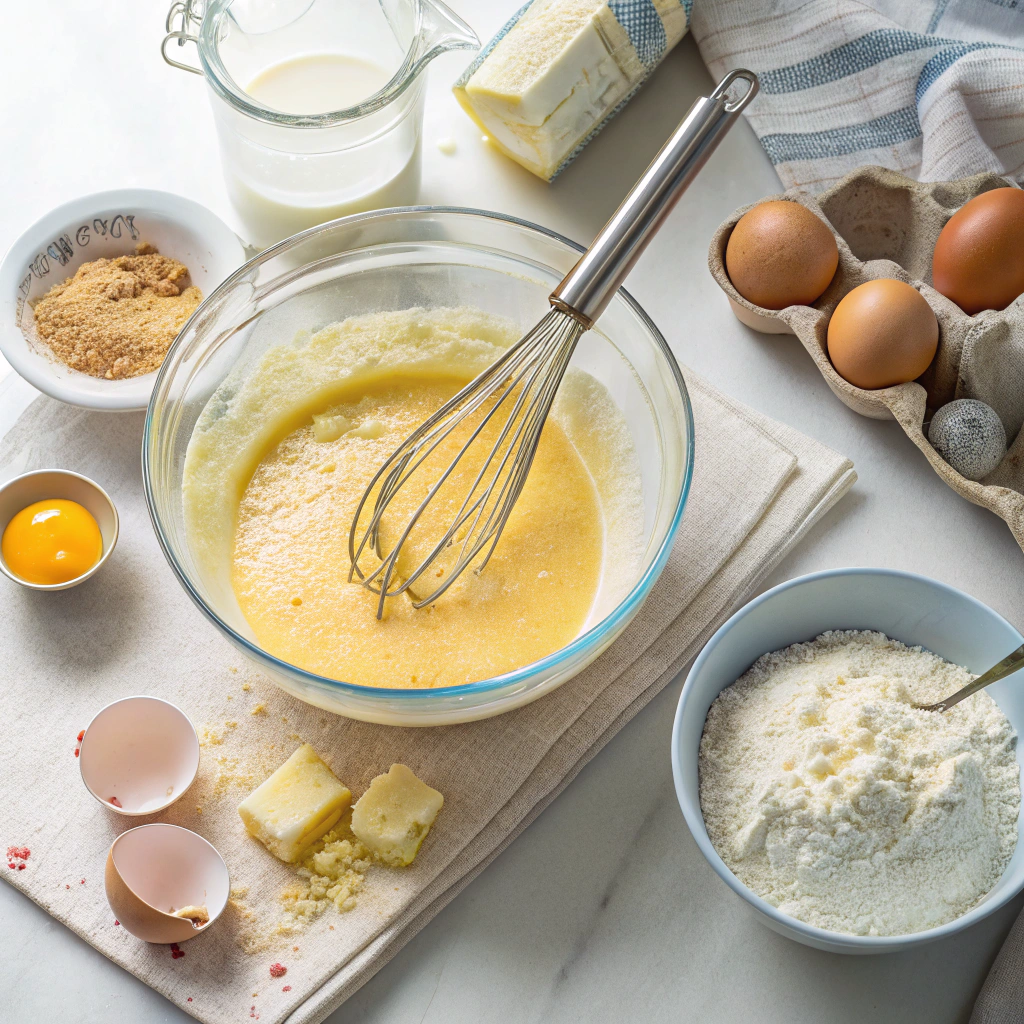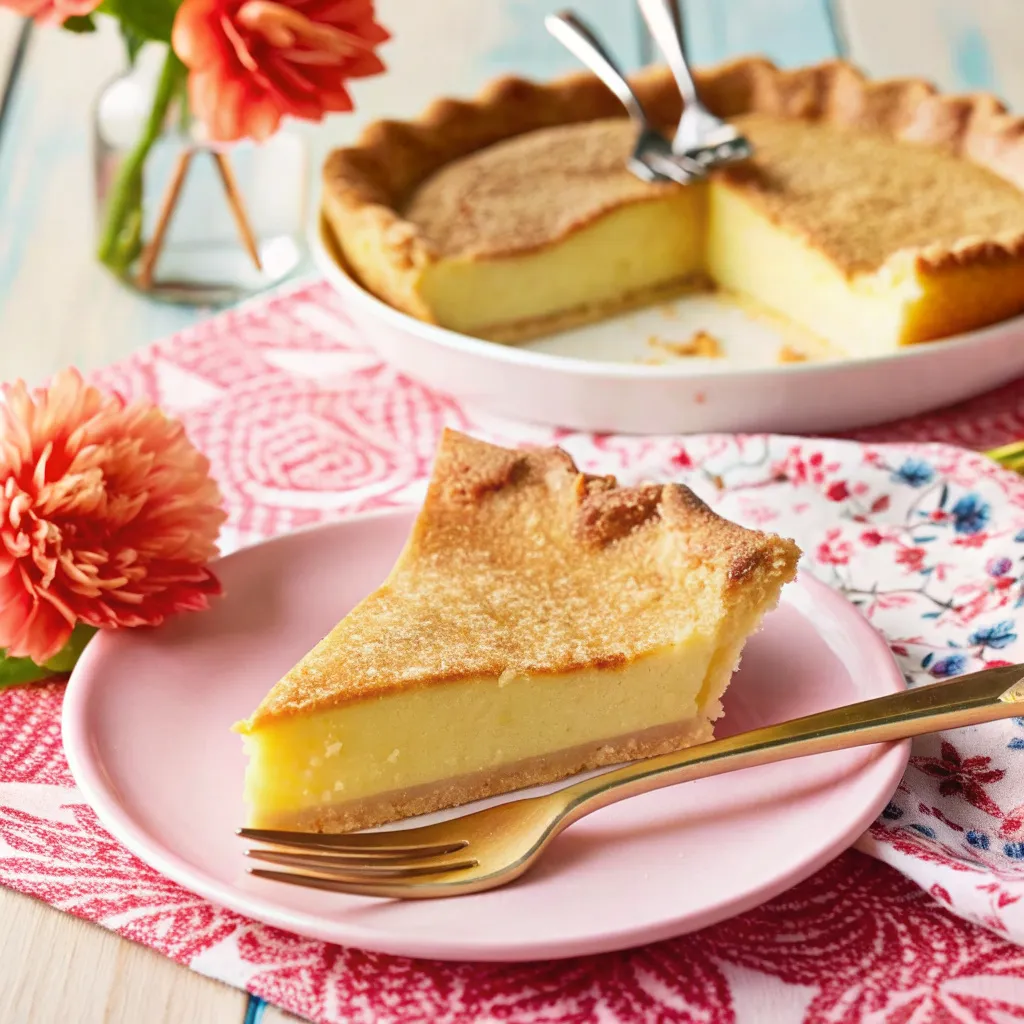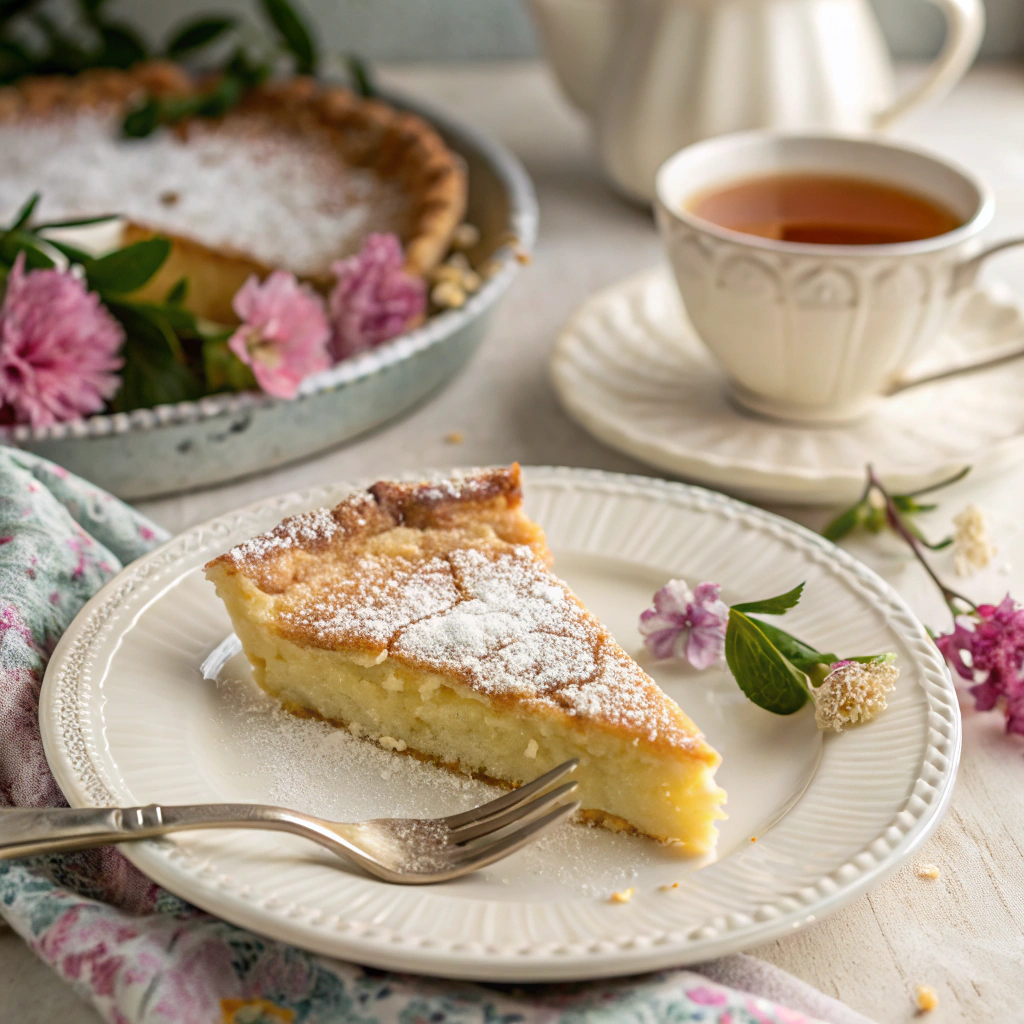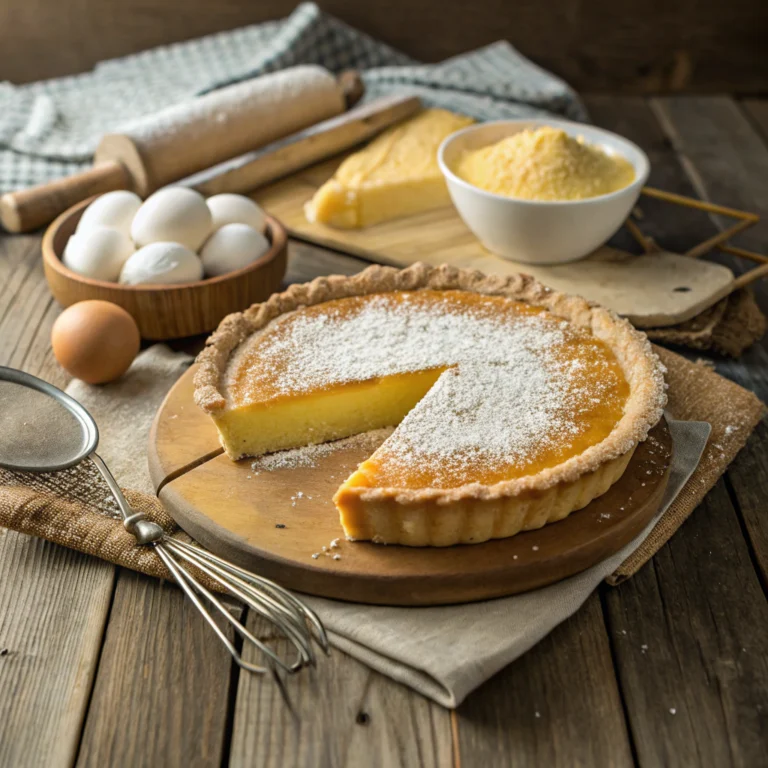Chess pie ingredients embody Southern baking simplicity—transforming basic pantry staples into luscious custard magic that warms the soul and connects us to generations of Southern baking traditions. This beloved dessert represents the essence of resourceful cooking, where everyday chess pie ingredients create extraordinary results through time-tested techniques and understanding.
Many home bakers struggle to achieve the perfect custard texture and understand how each ingredient contributes to the final masterpiece. The difference between a mediocre chess pie and an exceptional one lies not just in following directions , but in comprehending why specific chess pie ingredients work together to create that signature silky filling that sets properly every time.
Through this comprehensive guide, you’ll learn the science and techniques to master foolproof chess pie that rivals any Southern kitchen classic. We’ll explore each ingredient’s role, provide troubleshooting solutions, and share cultural insights that elevate your baking skills beyond simple recipe following.
Table of Contents
Essential Chess Pie Ingredients: The Science Behind Southern Tradition
Understanding chess pie ingredients requires appreciating both their individual properties and how they interact to create the perfect custard filling. Unlike complex desserts requiring specialized components, chess pie celebrates the transformation of humble ingredients through proper technique and timing.

Understanding Each Ingredient’s Role
The foundation of exceptional chess pie lies in comprehending how each component contributes to texture, flavor, and stability. Quality chess pie ingredients include eggs, butter, sugar, cornmeal, flour, milk, and vanilla—each serving specific scientific purposes beyond simple taste.
Eggs function as both the primary thickening agent and emulsifier, with proteins coagulating during baking to create the custard structure. The yolks provide richness and lecithin for smooth texture, while whites contribute to setting properties. Using room-temperature eggs ensures better incorporation and prevents curdling when combined with other chess pie ingredients.
Butter adds essential fat content that creates tenderness and richness while contributing to the golden color. The fat molecules coat flour proteins, preventing tough texture development. Unsalted butter allows better control over the final flavor profile, letting the natural sweetness of other chess pie ingredients shine through.
Sugar serves multiple functions beyond sweetness—it tenderizes the custard by interfering with protein development, aids in browning reactions, and helps retain moisture. The type of sugar affects texture, with granulated sugar providing clean sweetness while brown sugar adds depth and slight molasses notes to complement traditional chess pie ingredients.
Cornmeal distinguishes chess pie from other custard desserts, providing subtle texture and nutty flavor while contributing to proper setting. The science of cornmeal in baking reveals how this ingredient absorbs moisture and creates the characteristic slightly grainy texture that defines authentic chess pie.
Quality Selection Tips
Selecting superior chess pie ingredients directly impacts your final results. Fresh, high-quality components ensure consistent texture and optimal flavor development throughout the baking process.
Choose eggs with bright orange yolks from pasture-raised hens when possible, as these contain higher fat content and better emulsification properties. Check freshness by placing eggs in water—fresh eggs sink completely while older ones float, indicating compromised quality that affects how chess pie ingredients bind together.
European-style butter with higher fat content (82-85%) produces superior results compared to standard American butter. The increased fat percentage creates richer texture and better browning, essential for developing the golden top characteristic of properly prepared chess pie using quality chess pie ingredients.
Fine-ground cornmeal works better than coarse varieties for smooth custard texture. Yellow cornmeal provides traditional color and flavor, while white cornmeal offers more subtle taste if you prefer highlighting other chess pie ingredients. Avoid pre-ground cornmeal older than six months, as oils become rancid and affect flavor negatively.
All-purpose flour with moderate protein content (10-12%) creates proper structure without toughness. Higher protein flours develop too much gluten when mixed with other chess pie ingredients, while lower protein varieties may not provide adequate structure for proper setting.
Substitution Guidelines
Understanding substitutions allows adaptation while maintaining the essential characteristics that make chess pie special. However, some chess pie ingredients are more critical than others and require careful consideration when making changes.
Whole milk provides optimal fat content and proteins for perfect custard consistency. Heavy cream creates richer results but may require reducing butter slightly to maintain proper fat balance among chess pie ingredients. Evaporated milk intensifies flavor and improves stability, making it excellent for humid climates where standard chess pie ingredients might struggle to set properly.
When eggs are limited, two whole eggs plus two egg yolks can substitute for three whole eggs, providing extra richness while maintaining emulsification properties. This adjustment works particularly well when combined with custard pie techniques that emphasize smooth, silky texture.
Vanilla extract enhances other flavors without overwhelming the delicate balance of chess pie ingredients. Pure vanilla extract provides superior results compared to imitation, while vanilla bean paste adds visual specks and intensive flavor. Almond extract can substitute partially for vanilla, using half the amount due to its stronger intensity.
The Science of Perfect Chess Pie Custard
Creating flawless chess pie custard requires understanding the chemical processes that transform liquid chess pie ingredients into smooth, set filling. The interaction between proteins, fats, and starches determines final texture and stability.
Temperature control plays the most critical role in custard formation. The custard chemistry principles explain how egg proteins begin coagulating around 140°F, with complete setting occurring by 160°F. Exceeding 180°F causes curdling as proteins contract and expel moisture, ruining the smooth texture achieved with proper handling of chess pie ingredients.
Gradual heating allows proteins to form networks that trap liquid, creating the creamy consistency characteristic of exceptional chess pie. Adding hot ingredients to cold eggs requires tempering—slowly incorporating small amounts while whisking constantly—to prevent shocking the proteins and creating lumpy texture.
The starch content from flour and cornmeal provides additional thickening power and stability to the custard structure. These starches gelatinize during baking, absorbing moisture and creating networks that support the protein matrix formed by properly handled chess pie ingredients.
Mastering the Perfect Chess Pie Crust Foundation
While chess pie ingredients for the filling receive primary attention, the crust foundation significantly impacts overall success. A properly prepared crust complements the custard without competing or becoming soggy during baking.
Creating perfect pie crust requires understanding how fat, flour, and liquid interact to create flaky layers. Cold butter creates steam pockets during baking, producing the light, crispy texture that supports rich chess pie filling without becoming soggy.
Pre-baking the crust prevents soggy bottoms that can occur when liquid chess pie ingredients are added to raw pastry. Blind baking for 10-12 minutes with pie weights creates a barrier that maintains crispness throughout the custard baking process.
Proper crimping and edge treatment not only provide visual appeal but also create structural integrity that prevents overflow during baking when chess pie ingredients expand with heat. High edges contain the filling while allowing proper browning and setting.

Troubleshooting Common Chess Pie Challenges
Even experienced bakers encounter issues when working with chess pie ingredients, but understanding common problems and solutions ensures consistent success with every attempt.
Curdled filling typically results from temperature shock when combining chess pie ingredients. Always bring eggs to room temperature before mixing, and add any warm components gradually while whisking constantly. If curdling occurs, strain the mixture through fine mesh to remove lumps before baking.
Cracked surfaces indicate overbaking or too-rapid temperature changes. Reduce oven temperature by 25°F and extend baking time for gentler cooking that allows chess pie ingredients to set evenly without stress cracks. Opening the oven door frequently during baking also causes temperature fluctuations that lead to cracking.
Runny centers often result from underbaking or incorrect ratios among chess pie ingredients. The filling should jiggle slightly in the center when properly done, with edges completely set. An instant-read thermometer should register 160°F in the center for optimal doneness.
Weeping or separation occurs when the custard structure breaks down due to overbaking or ingredient imbalances. Maintaining proper ratios and gentle baking temperatures prevents this issue that compromises both texture and appearance of carefully prepared chess pie ingredients.
Frequently Asked Questions About Chess Pie Ingredients
Can I substitute ingredients in traditional chess pie recipes without compromising texture?
Yes, but certain chess pie ingredients are more essential than others. Eggs, cornmeal, and flour form the structural foundation and should be substituted carefully. Milk can become heavy cream or evaporated milk, sugar can be partially replaced with brown sugar, and butter can be substituted with high-quality margarine if needed. However, maintain the ratios between wet and dry ingredients to preserve proper custard consistency.
How do I know if my chess pie ingredients are properly combined?
Properly mixed chess pie ingredients should create a smooth, homogeneous mixture without visible lumps or separation. The filling should coat a spoon lightly and pour in a steady stream. Overmixing can develop gluten and create tough texture, while undermixing leaves streaks that affect final consistency. Mix just until ingredients are evenly incorporated.
What causes chess pie ingredients to separate during baking?
Separation typically occurs when chess pie ingredients are too cold when combined, mixed at incorrect speeds, or baked at temperatures that are too high. Ensure all ingredients reach room temperature before mixing, combine gently but thoroughly, and maintain moderate oven temperatures (325-350°F) for even cooking that prevents protein coagulation from happening too rapidly.
How long do chess pie ingredients stay fresh, and how should I store them?
Fresh chess pie ingredients should be used within their individual expiration dates for optimal results. Eggs stay fresh 3-5 weeks refrigerated, butter maintains quality for 1-3 months, and cornmeal lasts 6-12 months in cool, dry storage. Always check ingredients for freshness before combining, as old components can affect texture and flavor even when mixed with fresh chess pie ingredients.
Why does my chess pie filling taste different each time I use the same ingredients?
Variations in chess pie ingredients quality, temperature, and mixing techniques affect final flavor profiles. Seasonal changes in eggs and dairy, different brands of cornmeal, and varying mixing times all influence taste. For consistency, use the same brands when possible, maintain consistent mixing techniques, and ensure all chess pie ingredients reach proper temperature before combining.
Can I make chess pie ingredients healthier without losing traditional taste?
Some modifications work better than others with chess pie ingredients. Using organic or pasture-raised eggs improves nutritional content without changing texture. Reducing sugar slightly (up to 25%) maintains sweetness while cutting calories. However, significant substitutions like non-dairy milk or egg replacers fundamentally alter the custard science that makes chess pie work, potentially compromising the traditional texture and flavor.
Conclusion
Mastering chess pie ingredients transforms simple baking into an art form that honors Southern culinary traditions while ensuring consistent, delicious results. Understanding how each component contributes to the final product—from eggs providing structure to cornmeal adding signature texture—empowers you to create exceptional desserts that rival any family recipe passed down through generations.
The science behind chess pie ingredients reveals that success depends not just on following directions, but on comprehending the chemical processes that create smooth custard from basic pantry staples. Temperature control, proper mixing techniques, and quality ingredient selection work together to produce the silky texture and rich flavor that define authentic Southern chess pie.

Whether you’re continuing family traditions or discovering chess pie for the first time, this foundation in ingredient science and technique ensures your baking adventures celebrate the rich Southern culinary heritage that makes this dessert timelessly appealing. Practice these principles, experiment with quality ingredients, and soon you’ll be creating chess pie that brings warmth and satisfaction to every table you serve.
PrintSouthern Chess Pie
- Total Time: 3 hours 5 minutes
- Yield: 8 servings 1x
- Diet: Vegetarian
Description
This authentic Southern Chess Pie celebrates the transformation of humble ingredients into a sublime custard dessert through proper technique and timing. Unlike complex desserts requiring specialized components, chess pie showcases how eggs, butter, sugar, cornmeal, and milk combine to create a smooth, silky custard with the characteristic slightly grainy texture that defines this beloved Southern tradition. The secret lies in understanding the science behind each ingredient and maintaining precise temperature control for perfect results every time.
Ingredients
- For the Filling:
- 3 large eggs, room temperature
- 1½ cups granulated sugar
- ½ cup (1 stick) unsalted butter, melted and slightly cooled
- ¼ cup whole milk
- 2 tablespoons fine-ground yellow cornmeal
- 1 tablespoon all-purpose flour
- 1 teaspoon pure vanilla extract
- ¼ teaspoon salt
- For the Crust:
- 1 unbaked 9-inch pie crust (store-bought or homemade)
Instructions
- Prepare for Success: Preheat oven to 350°F. Ensure all ingredients are at room temperature for better incorporation. Pre-bake pie crust for 10-12 minutes with pie weights to prevent soggy bottom, then remove weights and bake 2-3 more minutes until lightly golden.
- Create the Custard Base: In a large mixing bowl, whisk eggs until well beaten. Gradually add sugar, whisking continuously until mixture is smooth and sugar begins to dissolve.
- Add Dry Ingredients: Whisk together cornmeal, flour, and salt in a small bowl. Gradually add this mixture to the egg-sugar base, whisking constantly to prevent lumps from forming.
- Incorporate Liquids: Slowly add melted butter while whisking vigorously to prevent eggs from cooking. The mixture should remain smooth and well-incorporated. Add milk and vanilla extract, whisking until completely combined.
- Fill and Bake: Pour the custard mixture into the pre-baked crust, filling to about ¾ full. Gently tap the pan to release air bubbles.
- Bake to Perfection: Bake for 35-45 minutes until the center jiggles only slightly when gently shaken. The internal temperature should reach 160°F. The surface should be golden brown with no wet spots.
- Cool and Set: Allow pie to cool completely at room temperature for at least 2 hours before slicing. This allows the custard to fully set and develop proper texture.
Notes
Temperature Science: Egg proteins begin coagulating at 140°F and complete setting at 160°F. Exceeding 180°F causes curdling, so gentle, controlled baking is essential. Ingredient Quality: Use room-temperature eggs for better incorporation and pasture-raised when possible for richer flavor. European-style butter (82-85% fat) produces superior results. Troubleshooting: If filling curdles, strain through fine mesh before baking. Cracks indicate overbaking – reduce temperature by 25°F and extend time. Storage: Refrigerate up to 3 days, though best served within 24 hours. Pro Tips: The cornmeal provides the characteristic slightly grainy texture that distinguishes chess pie from other custards. High pie crust edges prevent overflow during baking.
- Prep Time: 20 minutes
- Cook Time: 45 minutes
- Category: Dessert
- Method: Baking
- Cuisine: Southern
Nutrition
- Serving Size: 1 slice (1/8th of pie)
- Calories: 385
- Sugar: 32g
- Sodium: 285mg
- Fat: 18g
- Saturated Fat: 10g
- Unsaturated Fat: 6g
- Trans Fat: 0g
- Carbohydrates: 52g
- Fiber: 1g
- Protein: 6g
- Cholesterol: 95mg
Keywords: chess pie, southern dessert, custard pie, cornmeal pie, traditional southern baking

